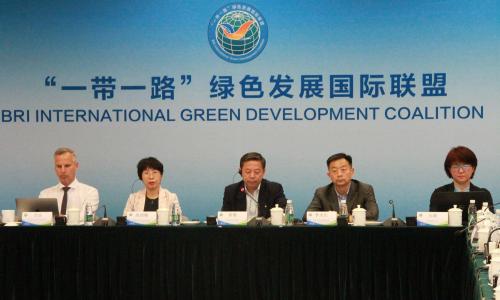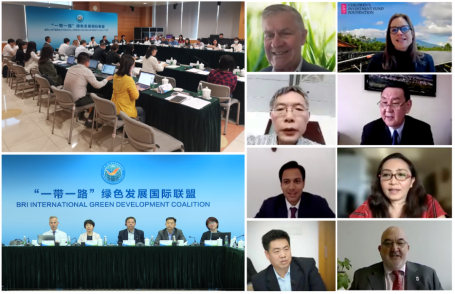
WRI co-sponsors multi-stakeholder roundtable on Green Development Guidance for BRI
BEIJING (May 17, 2021)- World Resources Institute convened a multi-stakeholder meeting on Green Development Guidance for BRI projects in collaboration with the BRI International Green Development Coalition, ClientEarth and WWF, bringing together environment and banking regulators, environment groups, research institutes and state investors for discussions over green finance for BRI projects in the global context of a net-zero future.
In alignment with the Chinese government’s carbon-neutrality pledges and calls for a green BRI, the meeting addressed challenges facing Chinese investors in mitigating overseas environmental risks, and supporting the energy transition and sustainable green recovery of BRI countries. Panelists discussed progress in the GDG phase-II study, adding clarity to the application guidelines for stakeholders and technical guidelines for transportation infrastructure to improve the research. As the BRIGC’s most recent effort to share knowledge and learnings in green finance aligned with net-zero policies and standards of BRI countries, the meeting served to build consensus and solidarity among multiple stakeholders in the green development of BRI.
The opening session was chaired by Li Yonghong, Deputy Director General of Foreign Environmental Cooperation Center (FECO) under the Ministry of Ecology and Environment (MEE). Opening remarks were delivered by Erik Solheim, Convener of the BRIGC Advisory Committee, Senior Advisor of World Resources Institute, Guo Jing, Director General of the Department of International Cooperation of MEE, Kate Hampton, Convener of the BRIGC Advisory Committee, Chief Executive Officer of Children’s Investment Fund Foundation, and Zhou Guomei, Director General of FECO of MEE.

Li Yonghong said the meeting was expected to facilitate multi-stakeholder discussion on building the BRI projects through green finance, and on the BRIGC’s near-term action plans.
Erik Solheim accentuated the ongoing global efforts to address climate change, saying that trans-border cooperation should be encouraged in a positive direction. Stressing the role of Green Investment Principle for the BRI, he suggested that members of the global community stop financing for coal and increase wind and solar investments. China should promote its green technology overseas by working together with BRI countries to boost their domestic demand, he said.
President Xi Jinping attached great importance to BRIGC’s fruitful efforts and made reference to the coalition on four separate occasions in the past three years, Guo Jing noted. The BRIGC’s collective efforts in formulating the GDG and driving it forward had undoubtedly given momentum to China’s coal restrictions which transpired within a short period of time, and would likely make a substantial difference to the country’s overseas coal financing, he said.
Kate Hampton pointed to climate change as one of the major threats facing children and young people in the future. It has been exciting to learn the net-zero pledges from around the world, and the top priority now is to translate those long-term pledges into near-term action, she said. Despite the difficulties presented by the pandemic, some of the most vulnerable countries to climate change, including Pakistan, the Philippines and Vietnam have announced stringent restrictions on coal-fired power projects and decided to step up support for renewable energy. South Korea pledged to end state funding of overseas coal at the Leaders' Summit on Climate in April, and the UK announced in last December that it will end support for fossil fuel sector overseas. In that context, China can play a leading role in actively promoting a global green-development agenda, advocating and enhancing green-finance cooperation along the BRI, and helping BRI countries achieve their energy transition and green recovery, she said.
China has been actively promoting green finance along the BRI routes with a view to building a Green Belt and Road, Zhou Guomei said. Renewable energy is gathering momentum in BRI countries and beyond, outpacing fossil fuels as a development trend. The Chinese government places a premium on the environmental aspect of the country’s BRI investments, she said. Stakeholders should continue to build on the BRIGC’s policy-communication platforms, actively developing green finance and other tools to prevent environmental risks along the Belt and Road, and making sure BRI projects are built to be green, she said.
Fang Li, Chief Representative of World Resources Institute China, moderated the panel discussion on national policy and standards. As one of the meeting’s cosponsors, WRI is committed to bridging the gap between science and policy, having played a key role in the signing of the Paris Agreement, she said. Advancing international climate action, WRI is dedicated to helping countries put ideas into concrete steps by delivering comprehensive and effective tools and solutions, she said.
Ye Yanfei, Counsel of the Policy Research Bureau, China Banking and Insurance Regulatory Commission, discussed national policy and standards with representatives from Mongolia, Pakistan and Indonesia, focusing on each country’s green-finance practices in the global net-zero context. Ye said the concept of low carbon should be underscored in the course of greening the BRI and “Going Global”. While developing countries strive to turn carbon-reduction targets into concrete plans, timetables and roadmaps, China’s finance regulators should increase communications and cooperation with local financial institutions, investors and environment groups, and pay more attention to what they have to say, Ye said. Mustafa Hyder Sayed, Executive Director at Pakistan-China Institute, suggested sovereign guarantees be given to green projects within the BRI to encourage investments in green infrastructure including green power plants. He also suggested Pakistan’s national grid system be upgraded in a way that allows renewable energy projects to be integrated into the grid to better facilitate the country’s renewable energy transition.
Suzanty Sitorus, Indonesia Country Director of Tara/European Climate Foundation, highlighted the role that Indonesia plays in promoting sustainable finance standards in ASEAN, and the fact that ASEAN central banks recently agreed on sustainable banking principles. Those principles will serve to help ASEAN central banks develop further sustainable banking guidelines and tools aligned with each respective country’s context, she said. She expressed hopes for better knowledge of China’s current environmental regulations governing overseas investments, which could be used to help ASEAN countries improve energy structures.
Christoph Nedopil, Director of the Green BRI Center at Central University of Finance and Economics, compared the costs of producing electricity from different sources of energy including solar and coal, saying that the high cost of coal-fired electricity will likely cause increasingly more stranded asset risks for investors in power projects. He underlined a number of challenges facing investors including how to ensure the environmental risk management capacity of financial institutions and EPC contractors, how to create a pipeline of green projects to invest in, and how to verify the green implementation of projects that are being invested in, among other issues related to the need to “move from brown to green”.
Zhao Zhongpu from China Export & Credit Insurance Corporation (SINOSURE) said that the company placed green investments in the “strongly encouraged” category, stepping up support for solar power and new-energy vehicles, putting strict restrictions on heavily-polluting and energy-intensive imports and exports underwriting, helping investors transition and upgrade, and increasing the quality and efficiency of the economy.
Mr. Liu Qiang, Director of Programmes at the China office of Children's Investment Fund Foundation, suggested that Chinese financial institutions could better align themselves with international standards by incorporating climate considerations into their efforts in promoting green finance in BRI countries, to restrict fossil fuels and encourage the development of renewable energy, particularly wind and solar power. In addition, fundamental efforts such as data disclosure should be enhanced to guide BRI investments and financing in the green direction.
Lan Yan, Deputy Director of the BRIGC Secretariat, discussed the green development of transportation infrastructure with panelists from WWF, Transport Planning and Research Institute of the Ministry of Transport, China Harbour Engineering Company Limited, and China Railway Construction Corporation Limited.
In her closing remarks, Kate Hampton spoke highly of the good progress made by the BRIGC in greening the BRI. She suggested that multilateral context be fully considered, and multi-stakeholder cooperation among governments, businesses, investment institutions and thinktanks be strengthened. All efforts should be seen in the context of President Xi’s recent climate commitment, with a view to translating the GDG into concrete action and aligning China’s domestic and international ambitions, she said.
Background of the GDG:
The green development of BRI requires the prevention and management of eco-environmental risks, and green finance is one of the critical levers in advancing the sustainable overseas investment that ensures deepened cooperation under BRI. Meanwhile, in the context of global carbon neutrality, promoting green and low-carbon investment and financing has become a key agenda for BRI participating countries to address the challenges of climate change and to implement the 2030 Sustainable Development Goals.
With this understanding, the BRI International Green Development Coalition (BRIGC) launched the Joint Research Project on Green Development Guidance for BRI Projects (GDG) in 2019 and released the Phase I baseline study in 2020. The research set out to develop a project classification system based on the eco-environmental and climate impacts, together with a set of clear and operable guidelines, helps facilitating the decision-making of a range of stakeholders engaged in BRI projects. The World Resources Institute is the partner in BRIGC and co-leads two Thematic Partnerships in the field of green finance and investment, and green cities.
Continuing this effort, BRIGC launched the GDG phase II research, aiming to 1) develop a set of application guidelines for green development of BRI projects for different stakeholders such as financial institutions, enterprises and governments of BRI participating countries, 2) formulate technical guidelines for green development of transportation infrastructure (railways and highways), providing solutions to identify and prevent ecological and environmental risks and improve eco-environmental management.
Wang Ye, a leading co-author and green-finance research analyst with the World Resources Institute, said that the research project task force would provide concrete guidelines for the application of the GDG for the green development of BRI projects to aid policy making. The task force would provide more-clearly-defined application guidelines and illustrations to support the classification and differentiated management of BRI investment projects, with a view to assisting financial institutions and Chinese-funded enterprises in better coordinating resources and apparatus and working in tandem to green BRI investments, she said. It is expected that seminars like this roundtable on greening the BRI projects will develop into a regular communication mechanism between China and BRI countries, she said.